A Meatless Twist on a Classic French Dish
If you’re a vegan, you might think that traditional French dishes like beef bourguignon are off-limits. However, you’ll be happy to know that there are plenty of ways to enjoy this classic dish without sacrificing your dietary preferences. With the right ingredients and a little bit of creativity, you can make a delicious and hearty beef bourguignon that’s completely vegan.

One of the key components of beef bourguignon is the rich and flavorful broth that the meat is cooked in. To replicate this flavor, many vegan recipes use a combination of vegetable broth, red wine, and mushrooms. The mushrooms add a meaty texture and umami flavor that’s similar to beef, while the wine and broth create a savory base for the dish.
Another important element of beef bourguignon is the vegetables. Traditional recipes often include carrots, onions, and garlic, and vegan versions can use the same vegetables or add in others like potatoes or turnips. These vegetables add depth and nutrition to the dish, making it a filling and satisfying meal. So, if you’re looking for a vegan take on beef bourguignon, there are plenty of recipes out there that capture the essence of this classic French dish.
Understanding Vegan Beef Bourguignon

If you are a vegan and looking for a hearty, flavorful dish that is similar in taste to the traditional French recipe, then Vegan Beef Bourguignon is the perfect option for you. This dish is a veganized version of the classic French dish Beef Bourguignon, which is a popular French stew recipe originating from the Burgundy region in France.
Origins of Beef Bourguignon
Beef Bourguignon is a traditional French recipe that has been around for centuries. It is a slow-cooked beef stew that is braised in red wine and beef broth, and seasoned with a variety of herbs and spices. The dish is typically served with potatoes, carrots, and mushrooms. The origins of Beef Bourguignon can be traced back to the Burgundy region of France, where it was originally made with beef from the Charolais cattle breed.
Transition to Vegan Cuisine
As more and more people are adopting a vegan lifestyle, the demand for vegan versions of classic dishes like Beef Bourguignon has increased. Fortunately, there are many ways to make a vegan version of this dish that is just as delicious as the original.
The key to making a vegan version of Beef Bourguignon is to replace the beef with a plant-based protein such as seitan, tofu, or mushrooms. Mushrooms are a popular choice because they have a meaty texture and a rich, earthy flavor that is similar to beef. Additionally, red wine and vegetable broth can be used instead of beef broth to create a flavorful base for the stew.
In conclusion, Vegan Beef Bourguignon is a delicious and hearty dish that is perfect for vegans who are looking for a plant-based version of the classic French recipe. By using plant-based proteins and flavorful ingredients, you can create a dish that is just as satisfying and flavorful as the original.
Key Ingredients for Vegan Beef Bourguignon

If you’re looking to make a vegan version of the classic French dish, Beef Bourguignon, you’ll need to replace the beef with a meat substitute. There are several meat substitutes available, but seitan, textured soy protein, and mushrooms are the most commonly used ones.
Meat Substitutes
Seitan is a popular meat substitute made from wheat gluten. It has a meaty texture and can be flavored to mimic the taste of beef. Textured soy protein, on the other hand, is made from defatted soy flour and is often used as a substitute for ground beef. It has a chewy texture and can be rehydrated to mimic the texture of beef. Finally, mushrooms are another good option for a meat substitute. They have a meaty texture and can be flavored to mimic the taste of beef.
Aromatic Vegetables
Aromatic vegetables are an essential ingredient in Beef Bourguignon. They add depth and flavor to the dish. The most commonly used aromatic vegetables are onions, carrots, and garlic. Shallots can also be used instead of onions for a milder flavor. For a vegan version of the dish, you’ll need to replace the traditional bacon with a vegan alternative. You can use liquid smoke or smoked paprika to add a smoky flavor to the dish.
Herbs and Spices
Herbs and spices are used to add flavor to the dish. The most commonly used herbs and spices in Beef Bourguignon are thyme, rosemary, bay leaves, and black pepper. Thyme and rosemary are used to add a woody and earthy flavor to the dish, while bay leaves are used to add a floral flavor. Black pepper is used to add a spicy kick to the dish. You can also use other herbs and spices, such as parsley, sage, and oregano, to add more flavor to the dish.
In summary, to make a vegan version of Beef Bourguignon, you’ll need to replace the beef with a meat substitute, such as seitan, textured soy protein, or mushrooms. You’ll also need to use aromatic vegetables, such as onions, carrots, and garlic, and herbs and spices, such as thyme, rosemary, bay leaves, and black pepper, to add flavor to the dish.
Cooking Techniques and Tips

Sautéing Vegetables
To start making vegan beef bourguignon, you will need to sauté the vegetables. Use a large skillet or Dutch oven to sauté the shallots, garlic, and carrots until they are tender. You can use vegan butter or oil for sautéing. Make sure to slice the mushrooms and add them to the skillet later in the cooking process, so they don’t become too soft.
Simmering and Reducing
After sautéing the vegetables, you will need to add the vegetable broth and red wine. Bring the mixture to a boil, then reduce the heat and let it simmer for about an hour. This will allow the flavors to meld together and the sauce to thicken. You can add some herbs like thyme or rosemary to the sauce for extra flavor.
Thickening the Sauce
If you want a thicker sauce, you can add a slurry of cornstarch and water to the mixture. Mix equal parts of cornstarch and water in a small bowl, then add it to the sauce and stir until it thickens. Alternatively, you can also use a roux made from flour and vegan butter to thicken the sauce. Make the roux by melting vegan butter in a skillet, then whisking in flour until it forms a paste. Add the roux to the sauce and whisk until it thickens.
Overall, making vegan beef bourguignon requires some patience and attention to detail. But with the right cooking techniques and tips, you can create a delicious and hearty dish that everyone will enjoy. For more vegan recipes, check out The Friendly Feast or Ceara’s Kitchen.
Vegan Beef Bourguignon Recipe

If you are looking for a hearty and flavorful vegan dish that is perfect for any occasion, then this Vegan Beef Bourguignon Recipe is the perfect choice for you. This classic French dish is made with all the traditional ingredients, minus the beef, of course. This recipe is easy to make, and it will surely impress your guests.
Preparation Steps
To make this Vegan Beef Bourguignon Recipe, you will need the following ingredients:
- 1 cup of textured soy protein, sliced
- 1 cup of vegetable broth
- 1 cup of hot water
- ½ teaspoon of sea salt
- ½ teaspoon of ground pepper
- ½ teaspoon of smoked paprika
- ½ teaspoon of garlic powder
- 1 tablespoon of olive oil
- 1 onion, diced
- 2 cloves of garlic, minced
- 2 carrots, peeled and diced
- 2 celery stalks, diced
- 8 ounces of mushrooms, sliced
- 1 cup of burgundy wine
- 2 cups of vegetable broth
- 2 tablespoons of tomato paste
- 1 tablespoon of fresh thyme leaves
- 2 bay leaves
- Salt and pepper to taste
To prepare the ingredients, start by soaking the textured soy protein in vegetable broth and hot water for 10 minutes. Drain and squeeze out the excess liquid. Season the soy protein with sea salt, ground pepper, smoked paprika, and garlic powder.
Cooking Process
To cook the Vegan Beef Bourguignon, follow these steps:
- Heat the olive oil in a large pot over medium-high heat. Add the onion and garlic, and sauté for 2-3 minutes until fragrant.
- Add the carrots, celery, and mushrooms and sauté for another 5 minutes until the vegetables are tender.
- Add the soy protein and sauté for another 2-3 minutes until lightly browned.
- Pour in the burgundy wine and scrape the bottom of the pot to release any browned bits.
- Add the vegetable broth, tomato paste, thyme, bay leaves, salt, and pepper. Stir well to combine.
- Bring the mixture to a boil, then reduce the heat to low and let it simmer for 30-40 minutes until the sauce has thickened and the flavors have melded together.
Plating and Presentation
To serve the Vegan Beef Bourguignon, ladle it into bowls and garnish with fresh thyme leaves. This dish pairs well with mashed potatoes, rice, or crusty bread.
In conclusion, this Vegan Beef Bourguignon Recipe is a delicious and satisfying vegan alternative to the classic French dish. It is easy to make and packed with flavor, making it the perfect choice for any occasion.
Pairing with Side Dishes

When it comes to pairing side dishes with vegan beef bourguignon, there are a variety of options to choose from. You can either go for traditional French sides or contemporary vegan options.
Traditional French Sides
If you want to stick to the traditional French side dishes, then you can opt for sour cream and chive mashed potatoes, French bread rolls, and buttered corn and green beans. These sides complement the rich flavors of beef bourguignon and provide a satisfying meal.
Contemporary Vegan Options
For those who prefer vegan options, there are plenty of contemporary side dishes to choose from. You can go for vegan mashed potatoes, roasted root vegetables, or a mixed green salad with a tangy vinaigrette. These sides not only complement the flavors of vegan beef bourguignon but also provide a healthy and nutritious meal.
Another contemporary vegan option is to pair vegan beef bourguignon with wild rice pilaf. Wild rice has a nutty flavor and a chewy texture that perfectly complements the rich flavors of the stew. You can also serve the stew with quinoa, which is a complete protein and a good source of fiber.
In addition to these options, you can also serve vegan beef bourguignon with a glass of red wine. A full-bodied red wine such as Pinot Noir or Cabernet Sauvignon pairs well with the rich flavors of the stew.
Overall, when it comes to pairing side dishes with vegan beef bourguignon, there are plenty of options to choose from. Whether you prefer traditional French sides or contemporary vegan options, you can easily create a satisfying and nutritious meal that complements the rich flavors of the stew.
Nutritional Benefits
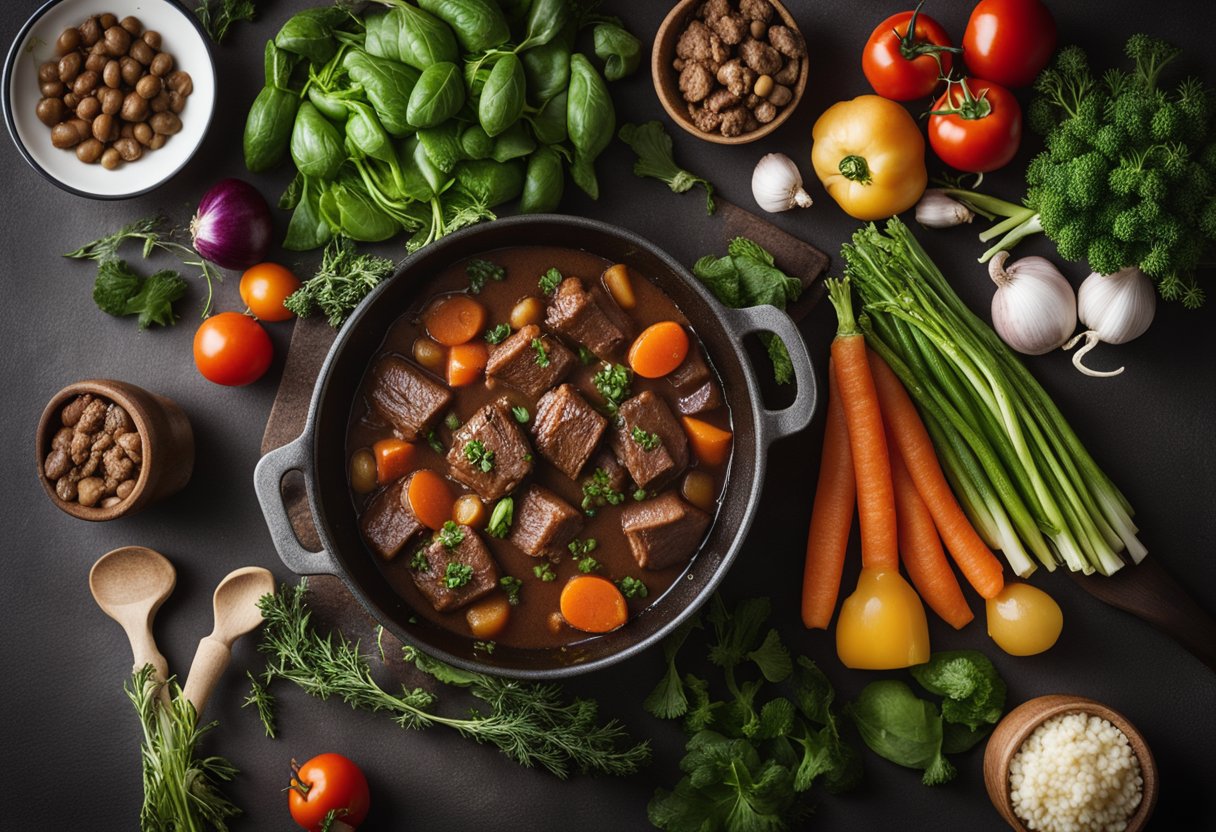
If you are looking for a vegan dish that is both delicious and nutritious, then you should try beef bourguignon vegan. This dish is packed with nutrients that are essential for your body. In this section, we will discuss the nutritional benefits of beef bourguignon vegan.
Protein Sources
Protein is an essential nutrient that helps your body build and repair tissues. Beef bourguignon vegan is a great source of protein. The main protein sources in this dish are mushrooms, lentils, and seitan. Mushrooms are a great source of protein, and they are also low in calories. Lentils are also a great source of protein, and they are rich in fiber, iron, and folate. Seitan is a great meat substitute, and it is also a great source of protein.
Vitamins and Minerals
Beef bourguignon vegan is also rich in vitamins and minerals. Here are some of the vitamins and minerals that you can get from this dish:
- Iron: Mushrooms, lentils, and seitan are all great sources of iron. Iron is important for the production of red blood cells.
- Zinc: Mushrooms are a great source of zinc, which is important for your immune system and metabolism.
- Vitamin B12: Seitan is a great source of vitamin B12, which is important for your nervous system and the production of red blood cells.
- Vitamin D: Mushrooms are a great source of vitamin D, which is important for your bones and immune system.
In conclusion, beef bourguignon vegan is a delicious and nutritious dish that you should try. It is a great source of protein, vitamins, and minerals. Whether you are a vegan or not, you will love this dish.
Adapting the Recipe for Allergies

If you have allergies or dietary restrictions, you can still enjoy a delicious vegan beef bourguignon by making a few simple adaptations to the recipe. Here are some tips for making gluten-free and nut-free versions of the dish:
Gluten-Free Adaptations
If you are gluten intolerant or have celiac disease, you can still enjoy vegan beef bourguignon by using gluten-free ingredients. Here are some substitutions you can make:
- Use gluten-free seitan or tempeh instead of regular seitan.
- Use gluten-free flour or cornstarch instead of regular flour to thicken the sauce.
- Serve the dish over gluten-free pasta, rice, or mashed potatoes.
Nut-Free Ingredients
If you have a nut allergy, you can still enjoy vegan beef bourguignon by using nut-free ingredients. Here are some substitutions you can make:
- Use soy curls or mushrooms instead of seitan.
- Use a nut-free vegetable broth instead of a nut-based broth.
- Use a different type of wine instead of a nutty burgundy wine.
By making these simple adaptations, you can enjoy a delicious vegan beef bourguignon without having to worry about allergies or dietary restrictions.
Wine Pairing and Vegan Beef Bourguignon

If you’re looking to pair wine with your vegan beef bourguignon, there are a few things to keep in mind. First, you’ll want to select vegan wines, which are made without the use of animal products such as gelatin or egg whites. Second, you’ll want to consider the taste profile of both the dish and the wine to ensure a complementary pairing.
Selecting Vegan Wines
When selecting vegan wines, look for wines that are labeled as vegan or that have been certified by a vegan organization. You can also look for wines that are made with alternative fining agents such as bentonite clay or activated charcoal. Some common vegan wine brands include Frey Vineyards, Bonterra Vineyards, and Our Daily Wines.
Taste Profiles
When it comes to pairing wine with vegan beef bourguignon, you’ll want to consider the dish’s rich, savory flavors. A full-bodied red wine such as a Cabernet Sauvignon or a Syrah pairs well with the dish’s bold flavors. Alternatively, a Pinot Noir or a Beaujolais pairs well with the dish’s earthy flavors. If you prefer white wine, a Chardonnay or a Viognier can complement the dish’s creaminess.
In conclusion, selecting a vegan wine to pair with your vegan beef bourguignon is all about finding a complementary taste profile. By considering the dish’s flavors and selecting a wine that complements them, you can create a delicious and satisfying meal.
Storing and Reheating
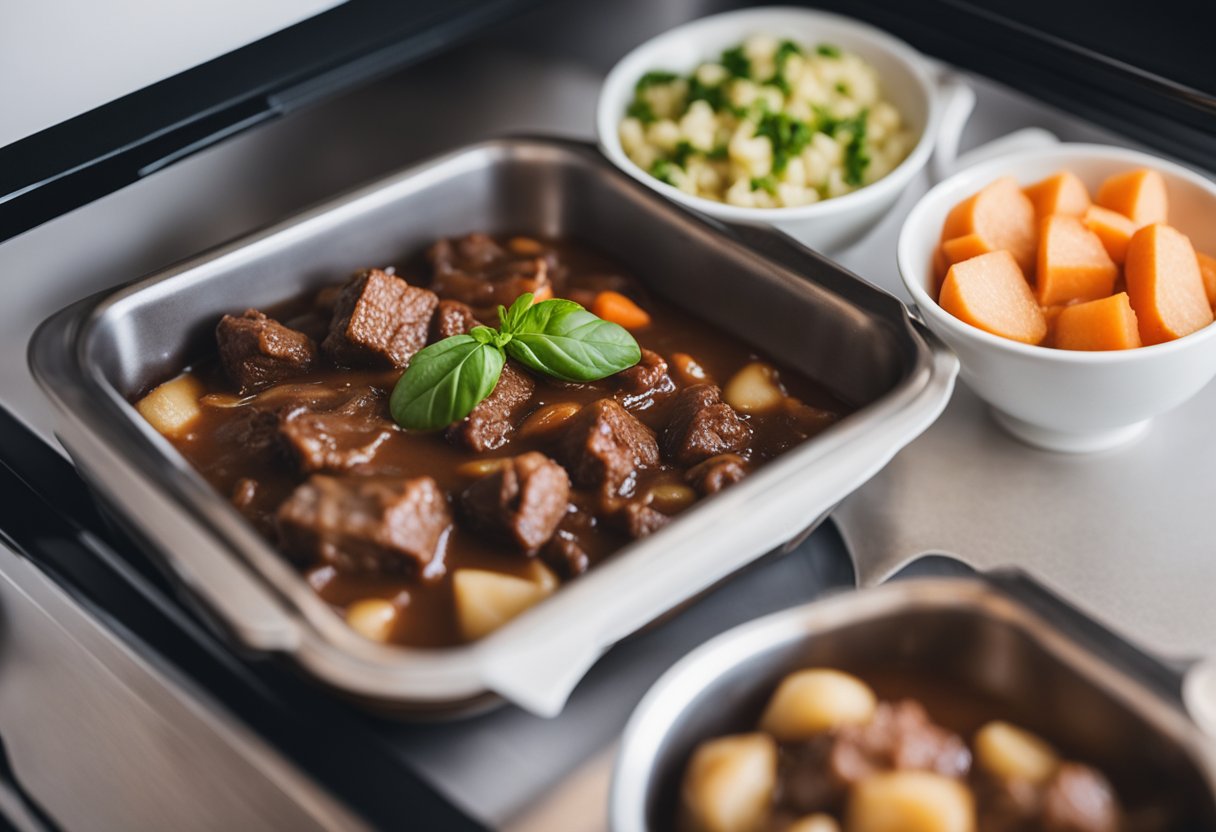
When it comes to storing and reheating vegan beef bourguignon, there are a few things to keep in mind to ensure that the dish retains its flavor and texture. Here are some tips and best practices to help you store and reheat your leftover vegan beef bourguignon.
Refrigeration Tips
Before refrigerating your vegan beef bourguignon, allow it to cool down to room temperature. Once cooled, transfer the dish to an airtight container and store it in the refrigerator. The dish can be stored in the refrigerator for up to four days.
To prevent the dish from drying out, you can add a small amount of vegetable broth or water to the container before refrigerating. This will help keep the dish moist and flavorful.
Best Practices for Reheating
When reheating your vegan beef bourguignon, there are a few things to keep in mind to ensure that the dish is heated evenly and retains its flavor and texture.
One of the best ways to reheat the dish is to use a microwave. Simply transfer the dish to a microwave-safe container and heat it on high for 1-2 minutes. Stir the dish after each minute to ensure that it is heated evenly.
Another option is to reheat the dish on the stovetop. Transfer the dish to a saucepan and heat it over medium heat, stirring occasionally, until it is heated through.
To prevent the dish from drying out, you can add a small amount of vegetable broth or water to the dish before reheating. This will help keep the dish moist and flavorful.
By following these tips and best practices, you can ensure that your leftover vegan beef bourguignon is just as delicious as when you first made it.
Scaling the Recipe for Events
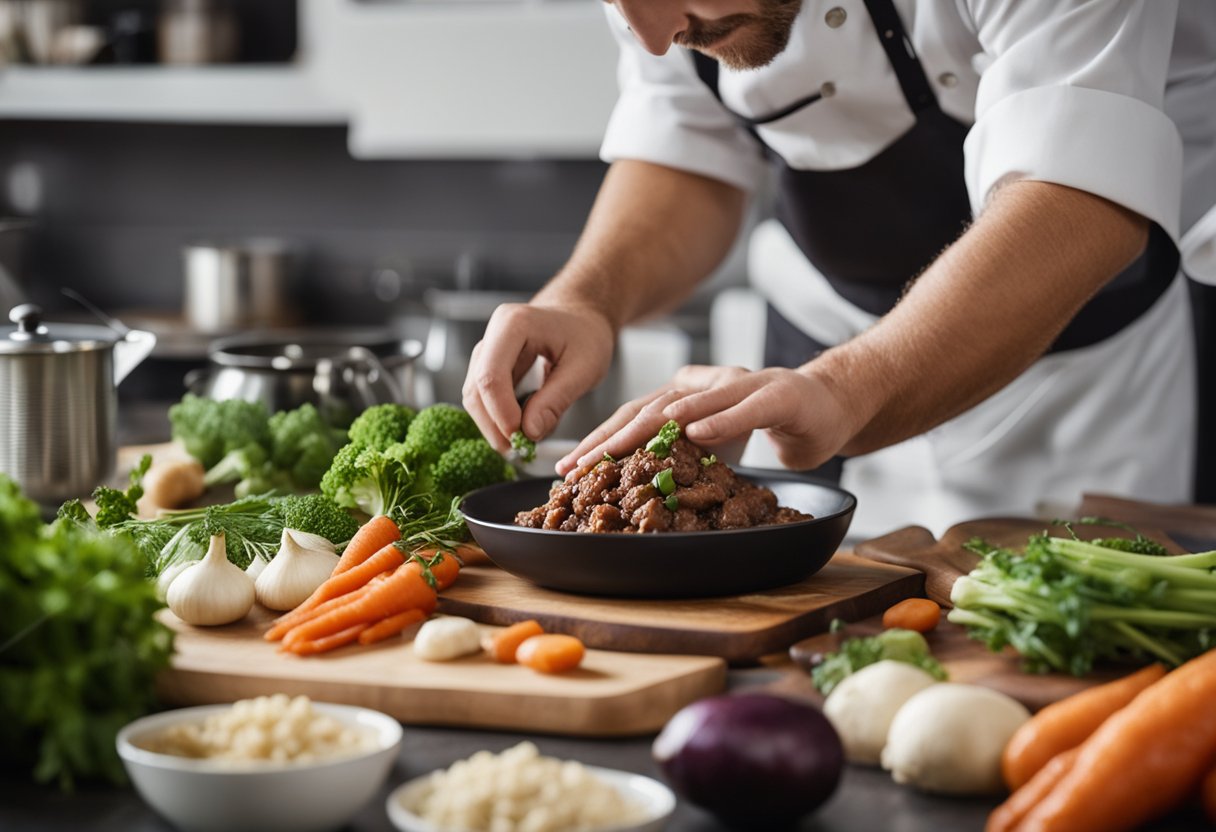
If you’re planning to cook vegan beef bourguignon for a large group of people, you’ll need to scale up the recipe. Here are some tips to help you do that.
Cooking for Large Groups
When cooking for a large group, it’s important to plan ahead. Make a list of all the ingredients you’ll need and buy them in bulk to save money. You can also prepare some of the ingredients ahead of time, such as chopping the vegetables and seitan.
To cook the vegan beef bourguignon in large quantities, you’ll need a large pot or several pots. Make sure you have enough space on your stove to accommodate them. You may also want to consider using a slow cooker or Instant Pot to cook the stew.
Here’s a table to help you scale up the recipe:
| Ingredients | Original Recipe | 10 Servings | 20 Servings |
|---|---|---|---|
| Seitan | 2 cups | 20 cups | 40 cups |
| Red Wine | 1 1/3 cup | 13 1/3 cups | 26 2/3 cups |
| Mushrooms | 16 oz. | 10 lbs. | 20 lbs. |
| Carrots | 2 large | 20 large | 40 large |
| Shallots | 2 | 20 | 40 |
| Garlic | 4 cloves | 40 cloves | 80 cloves |
Portion Control
When serving vegan beef bourguignon at an event, it’s important to control the portions to ensure that everyone gets a fair share. You can use a ladle to serve the stew into bowls or plates.
To make sure everyone gets an equal amount, you can use a measuring cup to portion out the stew. A 1/2 cup serving size is a good starting point, but you can adjust it depending on the size of the bowls or plates you’re using.
You can also serve the vegan beef bourguignon with a side dish, such as crusty bread or roasted vegetables, to make the meal more filling. This will help to stretch the stew further and ensure that everyone is satisfied.
By following these tips, you can easily scale up the vegan beef bourguignon recipe for your next event. Just remember to plan ahead, buy in bulk, and control the portions to ensure that everyone gets a taste of this delicious stew.
Sustainability and Veganism
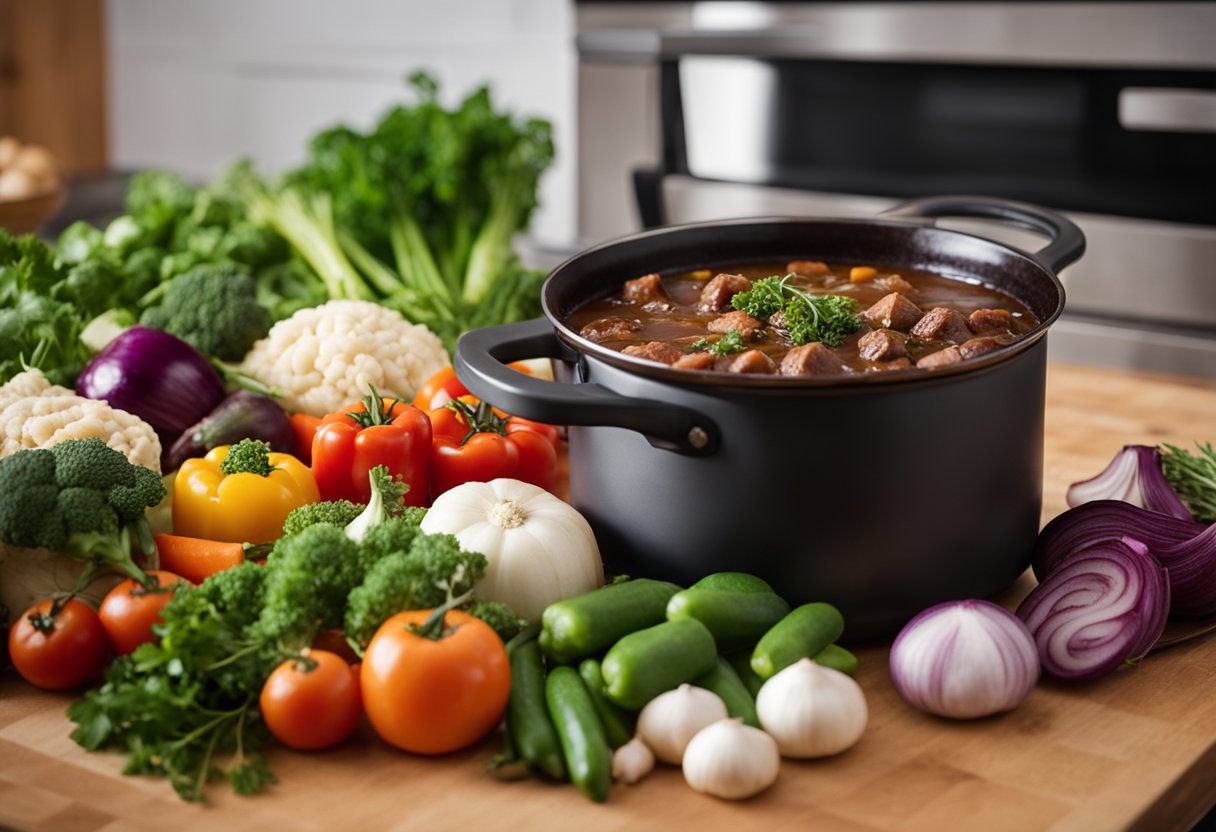
When it comes to choosing a diet that is not only healthy but also environmentally friendly, veganism is one of the best options. By eliminating animal products from your diet, you can significantly reduce your carbon footprint, water usage, and land use.
Beef, in particular, has a significant impact on the environment. According to the World Wildlife Fund, beef production is responsible for 60% of agriculture’s greenhouse gas emissions. Furthermore, it takes 20 times more land and water to produce a pound of beef than a pound of vegetables. By choosing a vegan beef bourguignon recipe, you can significantly reduce your impact on the environment.
In addition to being environmentally friendly, veganism also has health benefits. A plant-based diet is rich in fiber, vitamins, minerals, and antioxidants, which can help reduce the risk of chronic diseases such as heart disease, diabetes, and cancer. By choosing a vegan beef bourguignon recipe, you can enjoy a delicious meal that is both healthy and sustainable.
When it comes to making a vegan beef bourguignon recipe, there are several options for replacing the beef. Textured soy protein, mushrooms, and seitan are all great options for creating a meaty texture and flavor. By using these plant-based ingredients, you can create a dish that is just as satisfying as the traditional beef bourguignon recipe.
Overall, by choosing a vegan beef bourguignon recipe, you can enjoy a delicious meal while also reducing your impact on the environment and improving your health.
Frequently Asked Questions
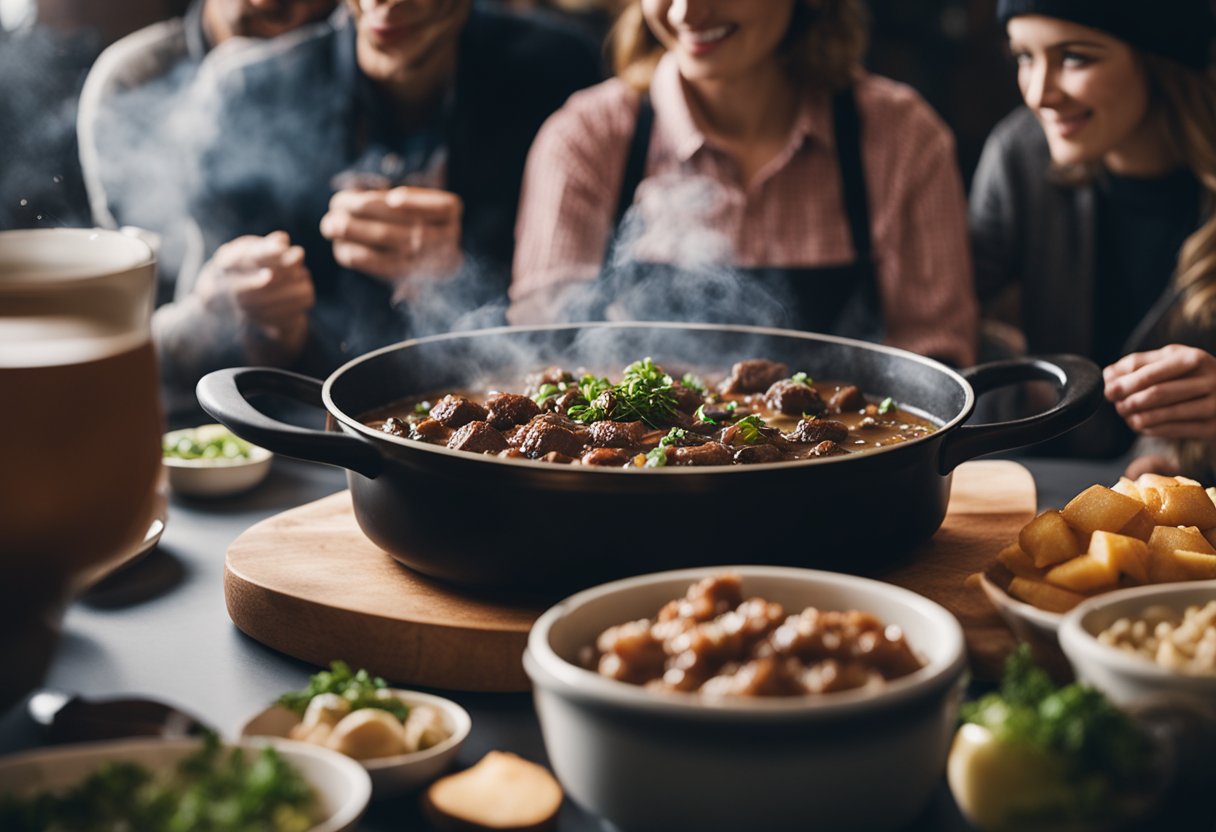
What are the best plant-based substitutes for beef in a bourguignon?
There are several plant-based substitutes that can be used in place of beef in a bourguignon. Some popular options include mushrooms, seitan, lentils, and jackfruit. Each of these substitutes has its own unique texture and flavor profile, so it’s important to choose the one that best suits your taste preferences.
How can I adapt a traditional beef bourguignon recipe to be vegan?
Adapting a traditional beef bourguignon recipe to be vegan is easier than you might think. Simply replace the beef with a plant-based substitute, such as mushrooms or seitan. You’ll also need to use vegetable broth instead of beef broth, and skip the butter and cream typically used in the recipe.
Which types of mushrooms work best for a vegan mushroom bourguignon?
When making a vegan mushroom bourguignon, it’s best to use a combination of different mushrooms to add depth of flavor and texture. Some popular options include cremini, shiitake, and oyster mushrooms.
Can seitan be effectively used to mimic the texture of beef in bourguignon?
Yes, seitan can be an effective substitute for beef in bourguignon. Seitan has a meat-like texture and can be seasoned to mimic the flavor of beef. However, it’s important to note that seitan has a distinct flavor of its own, so the end result may not be an exact replica of traditional beef bourguignon.
What are the key spices and herbs needed for an authentic vegan bourguignon flavor?
The key spices and herbs needed for an authentic vegan bourguignon flavor include thyme, rosemary, bay leaves, and garlic. These ingredients work together to create a rich, savory flavor that is characteristic of traditional beef bourguignon.
Is jackfruit a suitable alternative for beef in a bourguignon, and how should it be prepared?
Jackfruit can be a suitable alternative for beef in a bourguignon, but it requires a bit of preparation to get the right texture. To use jackfruit in a bourguignon, you’ll need to drain and rinse the canned fruit, then shred it with a fork to create a meat-like texture. You’ll also need to marinate the jackfruit in a flavorful sauce to enhance its flavor.
External Links
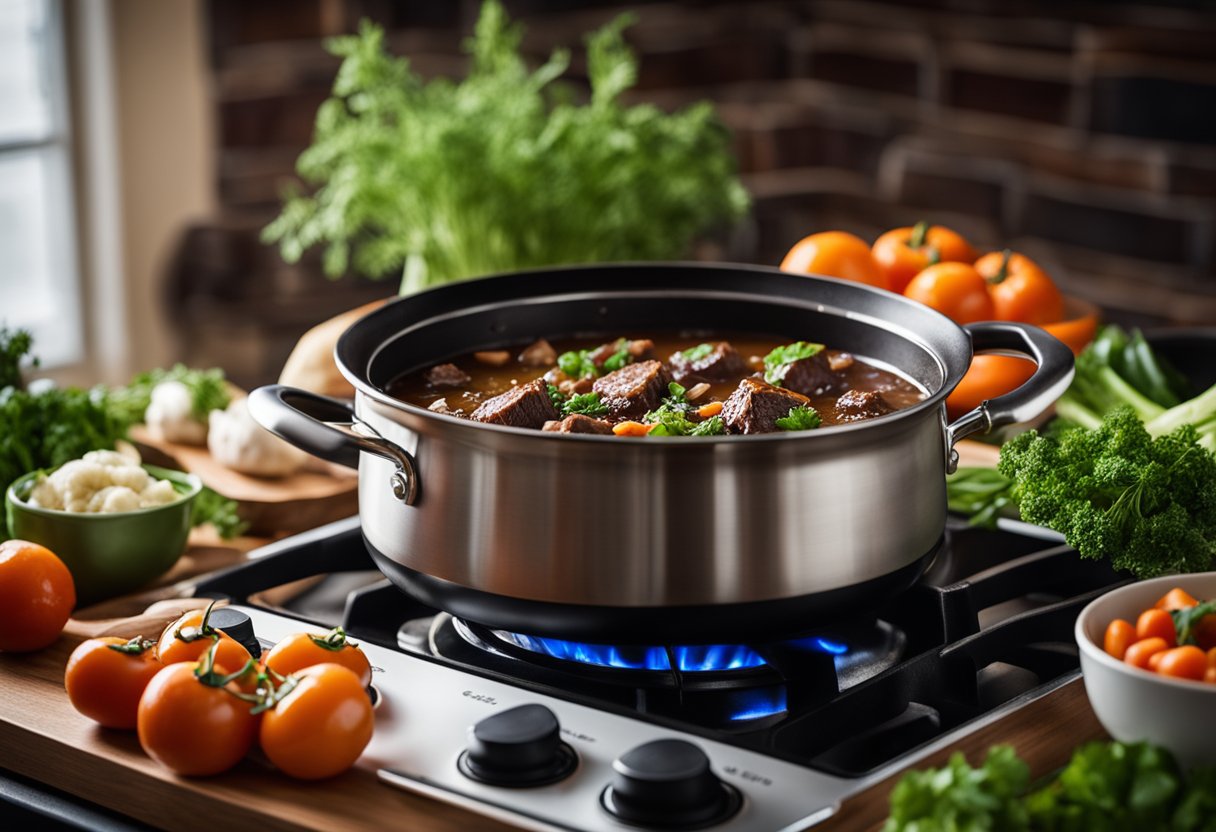
If you’re interested in learning more about vegan beef bourguignon, there are plenty of resources available online. Here are a few external links that you might find helpful:
- The Friendly Feast has a recipe for vegan beef bourguignon that uses faux meat and mushrooms, slow-cooked with wine and herbs. The dish is served over cauliflower puree, which complements the rich flavors of the bourguignon.
- Gourmandelle offers a vegan take on the classic French dish, using a combination of mushrooms, carrots, and soy curls to mimic the texture and flavor of beef. The recipe is simple to follow and yields a delicious, comforting stew.
- Vegan in the Freezer has a slow-cooker recipe for vegan beef bourguignon that’s packed with healthy vegetables like mushrooms and carrots. The dish has a rich broth and is hearty enough to satisfy even the most voracious appetites.
- The Cheap Lazy Vegan has a video tutorial on how to make vegan beef bourguignon. The recipe uses soy curls, mushrooms, carrots, and green peas to create a flavorful and filling dish.
- Ceara’s Kitchen offers a vegan beef bourguignon recipe that gets its rich, deep flavors from simmering on the stove on a very low heat. The recipe uses a handful of ingredients and is a simple and traditional French recipe.
These external links provide a variety of recipes and tutorials for making vegan beef bourguignon. Whether you’re a seasoned vegan cook or just starting out, you’re sure to find a recipe that suits your tastes and cooking style.
More FAQs

What are some good side dishes to serve with vegan beef bourguignon?
When it comes to serving vegan beef bourguignon, there are many side dishes that would complement the dish perfectly. Some popular options include:
- Mashed potatoes: The creamy texture of mashed potatoes pairs well with the rich, hearty flavors of the stew.
- Crusty bread: The bread can be used to soak up the flavorful sauce and add some crunch to the dish.
- Roasted vegetables: Roasted carrots, parsnips, and Brussels sprouts are all great options that would add some color and nutrition to the meal.
What type of wine should I use when making vegan beef bourguignon?
Traditionally, beef bourguignon is made with red wine, and the same is true for vegan beef bourguignon. A dry red wine such as a Pinot Noir or a Cabernet Sauvignon would work well in this recipe. However, if you prefer a non-alcoholic option, you can use vegetable broth instead.
Can I make vegan beef bourguignon in advance?
Yes, you can make vegan beef bourguignon in advance. In fact, the flavors tend to deepen and develop over time, so it’s a great dish to make ahead of time. You can store it in the refrigerator for up to three days or freeze it for up to three months. When reheating, be sure to do so slowly over low heat to prevent the vegetables from becoming mushy.
Conclusion
In conclusion, vegan beef bourguignon is a delicious and healthy alternative to the traditional French dish. By using plant-based ingredients such as mushrooms, carrots, and red wine, you can create a rich and flavorful stew that is satisfying and comforting.
One of the benefits of making vegan beef bourguignon is that it is lower in calories and fat than the original dish. Since it doesn’t contain any meat, it is also a great option for vegetarians and vegans. Additionally, by using a slow cooker, you can save time and effort while still achieving a delicious and hearty meal.
When making vegan beef bourguignon, it’s important to use high-quality ingredients and to let the stew simmer for a long time to allow the flavors to develop. You can also experiment with different herbs and spices to create a unique flavor profile that suits your taste.
Overall, vegan beef bourguignon is a great option for anyone looking for a healthy and tasty alternative to the classic French dish. With its rich and complex flavors, it’s sure to become a favorite in your household.
PrintVegan Beef Bourguignon Recipe
Vegan Mushroom Bourguignon
- Prep Time: 20 minutes
- Cook Time: 45 minutes
- Total Time: 1 hour 5 minutes
- Yield: 6 servings 1x
- Category: Main Dish
- Method: Saute
- Cuisine: French
- Diet: Vegan
Ingredients
- 2 tablespoons olive oil
- 1 large onion, diced
- 3 cloves garlic, minced
- 3 carrots, sliced
- 2 celery stalks, chopped
- 1 pound (450g) cremini mushrooms, sliced
- 1 pound (450g) pearl onions, peeled
- 3 tablespoons all-purpose flour
- 2 cups (480ml) vegetable broth
- 1 1/2 cups (355ml) red wine (check for vegan options)
- 2 tablespoons tomato paste
- 2 bay leaves
- 1 teaspoon thyme, dried
- Salt and pepper, to taste
- Fresh parsley, for garnish
Instructions
- In a large pot, heat olive oil over medium heat. Add diced onion and garlic, sauté until softened.
- Add carrots, celery, mushrooms, and pearl onions. Cook until the vegetables start to brown.
- Sprinkle flour over the vegetables, stirring well to coat. Cook for 2-3 minutes to remove the raw flour taste.
- Pour in the vegetable broth, red wine, and add tomato paste, bay leaves, thyme, salt, and pepper. Stir to combine.
- Bring the mixture to a simmer, then reduce heat to low. Cover and let it simmer for 30-40 minutes, or until the vegetables are tender.
- Remove the bay leaves and discard. Adjust seasoning if needed.
- Serve the vegan mushroom bourguignon over mashed potatoes, rice, or noodles. Garnish with fresh parsley.
Notes
For a richer flavor, you can marinate the mushrooms in red wine for a few hours before preparing the dish. Additionally, choose a good-quality vegetable broth to enhance the overall taste of the vegan bourguignon.
Nutrition
- Serving Size: 1 cup
- Calories: 280
- Sugar: 8g
- Sodium: 480mg
- Fat: 7g
- Carbohydrates: 35g
- Fiber: 6g
- Protein: 5g
- Cholesterol: 0mg
Keywords: Vegan Beef Bourguignon

